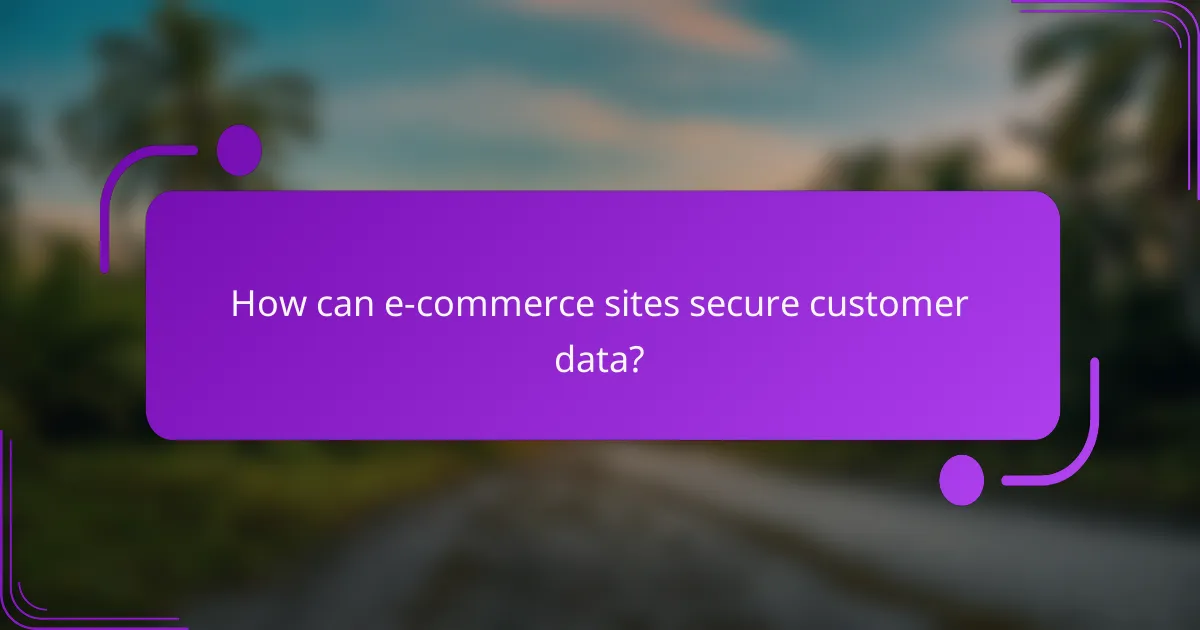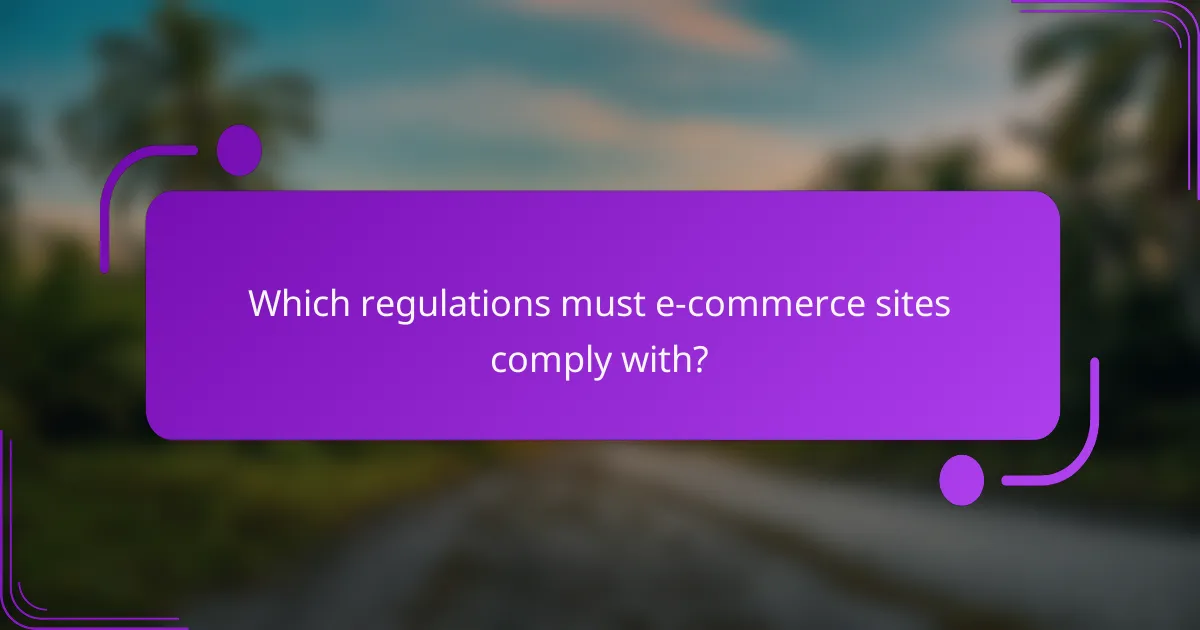Protecting customer data on e-commerce sites is essential for maintaining trust and compliance with regulations. Implementing robust security measures such as encryption, secure payment systems, and regular software updates can significantly reduce the risk of data breaches. Additionally, businesses should focus on data minimization, access control, and employee training to safeguard sensitive information effectively.

How can e-commerce sites secure customer data?
E-commerce sites can secure customer data by implementing robust security measures that protect sensitive information from unauthorized access. Key strategies include using encryption, secure payment systems, regular software updates, and conducting thorough security audits.
Implement HTTPS encryption
HTTPS encryption is essential for protecting customer data during transmission. It ensures that data exchanged between the user’s browser and the e-commerce site is encrypted, making it difficult for attackers to intercept sensitive information.
To implement HTTPS, obtain an SSL certificate from a trusted certificate authority. This certificate not only encrypts data but also builds customer trust, as users are more likely to shop on sites that display a secure connection.
Use secure payment gateways
Secure payment gateways are crucial for processing transactions safely. They handle sensitive payment information, such as credit card numbers, ensuring that this data is encrypted and securely transmitted.
Choose payment gateways that comply with PCI DSS (Payment Card Industry Data Security Standard) regulations. Popular options include PayPal, Stripe, and Square, which offer robust security features and fraud detection tools.
Regularly update software and plugins
Keeping software and plugins up to date is vital for maintaining security. Outdated systems can have vulnerabilities that cybercriminals exploit to access customer data.
Establish a routine for checking and updating all software components, including the e-commerce platform, plugins, and any third-party tools. Consider enabling automatic updates where possible to minimize risks.
Conduct security audits
Regular security audits help identify potential vulnerabilities in an e-commerce site. These audits assess the effectiveness of existing security measures and ensure compliance with industry standards.
Schedule audits at least annually or after significant changes to the site. Engage third-party security experts to conduct thorough assessments, as they can provide an objective view and recommend improvements to enhance data protection.

What are the best practices for data protection?
To effectively protect customer data on e-commerce sites, businesses should implement a combination of data minimization, access control measures, and regular employee training. These practices help reduce the risk of data breaches and ensure compliance with regulations.
Data minimization strategies
Data minimization involves collecting only the information necessary for specific transactions. For example, if a customer is purchasing a product, only essential details like name, address, and payment information should be collected, rather than excessive personal data.
Additionally, businesses should regularly review their data collection practices and eliminate any unnecessary data storage. This not only reduces the risk of exposure but also simplifies compliance with regulations such as GDPR.
Access control measures
Implementing strong access control measures is crucial for protecting customer data. This includes using role-based access controls (RBAC) to ensure that only authorized personnel can access sensitive information. For instance, customer service representatives should have limited access compared to IT staff.
Moreover, employing multi-factor authentication (MFA) adds an extra layer of security, making it more difficult for unauthorized users to gain access. Regular audits of access logs can help identify any suspicious activity.
Regular employee training
Regular employee training on data protection policies is essential for maintaining a secure environment. Employees should be educated on recognizing phishing attempts, handling customer data securely, and understanding the importance of compliance with data protection laws.
Training sessions should be conducted at least annually, with refreshers provided whenever new policies are introduced. This ensures that all staff members are aware of their responsibilities in safeguarding customer information.

Which regulations must e-commerce sites comply with?
E-commerce sites must comply with various regulations to protect customer data, including the General Data Protection Regulation (GDPR) and the California Consumer Privacy Act (CCPA). These laws set standards for data handling, privacy rights, and consumer protection, ensuring that businesses manage customer information responsibly.
General Data Protection Regulation (GDPR)
The GDPR is a comprehensive data protection law in the European Union that governs how personal data is collected, processed, and stored. E-commerce sites operating in or targeting customers in the EU must ensure they have explicit consent from users before collecting their data.
Key requirements include providing clear privacy notices, allowing users to access and delete their data, and reporting data breaches within 72 hours. Non-compliance can result in hefty fines, often reaching up to 4% of annual global revenue or €20 million, whichever is higher.
California Consumer Privacy Act (CCPA)
The CCPA is a state law that enhances privacy rights for residents of California. E-commerce businesses that meet certain criteria, such as having annual gross revenues over $25 million, must comply with this regulation, which gives consumers the right to know what personal data is being collected and how it is used.
Under the CCPA, customers can request the deletion of their data and opt out of the sale of their information. Businesses must provide a clear privacy policy and ensure that they have processes in place to handle consumer requests efficiently to avoid penalties.

How can businesses choose the right security tools?
Businesses can choose the right security tools by evaluating their specific needs, the features offered, and the reputation of the vendors. Selecting tools that align with the unique requirements of an e-commerce platform is crucial for effective customer data protection.
Evaluate security features
When evaluating security features, businesses should prioritize tools that offer encryption, secure payment processing, and compliance with standards like PCI DSS. Look for features such as two-factor authentication, fraud detection, and regular security updates.
Consider creating a checklist of essential features based on your business model. For instance, if you handle sensitive customer information, prioritize tools that provide advanced encryption and data masking capabilities.
Consider scalability
Scalability is vital for e-commerce businesses that anticipate growth. Choose security tools that can adapt to increasing transaction volumes and customer data without compromising performance. This ensures that as your business expands, your security measures remain robust.
Look for solutions that offer tiered pricing or modular features, allowing you to add capabilities as needed. This flexibility can save costs in the long run while ensuring comprehensive protection.
Assess vendor reputation
Vendor reputation plays a critical role in selecting security tools. Research potential vendors by checking reviews, testimonials, and case studies from similar businesses. A reputable vendor is more likely to provide reliable support and regular updates.
Additionally, consider vendors that are recognized for their commitment to security standards and have a track record of successfully protecting customer data. Engaging with industry forums or groups can also provide insights into vendor reliability and performance.

What are the consequences of data breaches?
Data breaches can lead to severe repercussions for e-commerce businesses, affecting their finances, reputation, and legal standing. Understanding these consequences is crucial for implementing effective data protection strategies.
Financial penalties
Financial penalties from data breaches can be substantial, often reaching into the millions of dollars. Regulatory bodies may impose fines based on the severity of the breach and the number of affected customers. For instance, under the General Data Protection Regulation (GDPR) in Europe, fines can be up to 4% of annual global revenue or €20 million, whichever is higher.
Additionally, businesses may face increased costs related to remediation efforts, such as upgrading security measures and monitoring affected accounts. These expenses can quickly add up, impacting overall profitability.
Loss of customer trust
A data breach can significantly erode customer trust, which is vital for any e-commerce site. Customers may feel vulnerable and hesitant to share their personal information, leading to decreased sales and customer retention. Surveys indicate that a large percentage of consumers would stop doing business with a company that experienced a data breach.
To rebuild trust, businesses must communicate transparently about the breach and the steps taken to enhance security. Offering compensation, such as credit monitoring services, can also help regain customer confidence.
Legal repercussions
Legal repercussions from data breaches can include lawsuits from affected customers and regulatory investigations. Customers may seek damages for identity theft or financial losses resulting from the breach, leading to costly legal battles. Class-action lawsuits can escalate these costs significantly.
Moreover, businesses must comply with various data protection laws, which may vary by region. Non-compliance can result in additional fines and legal challenges, making it imperative to stay informed about applicable regulations and ensure adherence to best practices in data security.

What emerging trends are shaping customer data protection?
Emerging trends in customer data protection focus on advanced technologies and regulatory changes that enhance security measures for e-commerce sites. These trends include the integration of artificial intelligence, stricter data privacy regulations, and an increased emphasis on transparency in data handling practices.
Increased use of AI for security
The use of artificial intelligence (AI) in security is rapidly growing, providing e-commerce sites with tools to better protect customer data. AI can analyze vast amounts of data in real-time, identifying patterns and anomalies that may indicate a security threat.
For instance, machine learning algorithms can detect unusual transaction behaviors, alerting businesses to potential fraud before it occurs. This proactive approach can significantly reduce the risk of data breaches and enhance overall customer trust.
However, implementing AI solutions requires careful consideration of costs and the need for ongoing training of the systems. Businesses should regularly update their AI models to adapt to new threats and ensure they comply with relevant regulations, such as the GDPR in Europe.
